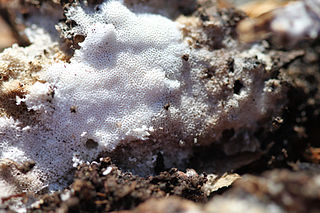Related Research Articles

The Meruliaceae are a family of fungi in the order Polyporales. According to a 2008 estimate, the family contains 47 genera and 420 species. As of April 2018, Index Fungorum accepts 645 species in the family.

The Steccherinaceae are a family of about 200 species of fungi in the order Polyporales. It includes crust-like, toothed, and poroid species that cause a white rot in dead wood.

Antrodiella is a genus of fungi in the family Steccherinaceae of the order Polyporales.
Amethicium is a fungal genus in the family Phanerochaetaceae. A monotypic genus, it contains the single species Amethicium rimosum, a crust fungus first reported from Tanzania in 1983. Amethicium is primarily characterized by its purple fruit body and a dimitic hyphal system. The felt-like tissue layer covering the substrate comprises a thin layer of densely intertwined skeletal hyphae.
Cericium is a fungal genus in the family Cystostereaceae. It is a monotypic genus with the single species Cericium luteoincrustatum, a crust fungus. This species was originally described in 1986 by Kurt Hjortstam and Leif Ryvarden, who called it Amethicium luteoincrustatum. They placed it in the genus Amethicium based on microscopic similarities with the African species Amethicium rimosum.

Hydnophlebia is a genus of five species of toothed crust fungi in the family Meruliaceae. All species are wood-decay fungi that cause a white rot.

Mycorrhaphium is a genus of fungi in the family Steccherinaceae. The genus was circumscribed by Dutch mycologist Rudolph Arnold Maas Geesteranus in 1962. The type species is Mycorrhaphium adustum. Fruit bodies of species in the genus have caps, stipes, and a hydnoid (tooth-like) hymenophore. There is a dimitic hyphal system, where the skeletal hyphae are found only in the tissue of the "teeth", and a lack of cystidia. The spores are smooth, hyaline (translucent), and inamyloid.
Megasporoporia is a genus of four species of crust fungi in the family Polyporaceae. The genus is characterized by its large spores, and dextrinoid skeletal hyphae.

Nigroporus is a genus of poroid fungi in the family Steccherinaceae. The genus was circumscribed by American mycologist William Alphonso Murrill in 1905. Nigroporus has a pantropical distribution. The genus name combines the Latin word niger ("black") with the Ancient Greek word πόρος ("pore").
Skeletocutis africana is a species of poroid crust fungus in the family Polyporaceae. Described as new to science in 2006 by mycologists Leif Ryvarden and Peter Roberts, the fungus is found in Cameroon, where it grows on logs in tropical lowland rainforest environments. The type collection was made in Korup National Park, in South West Province.
Antella is a genus of three species of crust fungi in the family Steccherinaceae.
Atraporiella is a monotypic fungal genus in the family Steccherinaceae. It contains the crust fungus Atraporiella neotropica, known only from Belize.
Junghuhnia japonica is a species of poroid crust fungus in the family Steccherinaceae. The type specimen was collected in Ōkuchi, Japan, growing on a rotting log of Castanopsis. The fungus is only known from the type locality. Its cylindric spores measure 4–5 by 2–2.4 µm and are smooth and hyaline. J. japonica has two types of cystidia. One type is thick walled and heavily encrusted, measuring 40–70 by 9–15 µm. The other type is tubular, smooth, and thin walled, measuring 20–35 by 4–8 µm. The latter type, which have an oily or granular appearance under the microscope, are known as gloeocystidia.
Trulla is a fungal genus in the family Steccherinaceae containing six species of polypores. It was circumscribed by mycologists Otto Miettinen and Leif Ryvarden in 2016, as a continuation of prior work that outlined a revised framework for the Steccherinaceae based on molecular phylogenetics. Its closest relative in the Steccherinaceae is the genus Nigroporus, from which it differs in its light-coloured fruit bodies and monomitic context.

Metuloidea is a genus of five species of fungi in the family Steccherinaceae. The genus was circumscribed by New Zealand-based mycologist Gordon Herriot Cunningham in 1965. The type species is M. tawa, a fungus originally described by Cunningham as a species of Trametes. Formerly classified in family Meruliaceae, Metuloidea was moved to the Steccherinaceae in 2016, following prior research that outlined a revised framework for the Steccherinaceae based on molecular phylogenetics.

Loweomyces fractipes is a species of poroid fungus in the family Steccherinaceae, and the type species of the genus Loweomyces. It is a widely distributed species, found in North America, Europe, Central America, South America, and Korea.

The Gelatoporiaceae are a small family of crust fungi in the order Polyporales. The family was circumscribed in 2017 by mycologists Otto Miettinen, Alfredo Justo and David Hibbett to contain the type genus Gelatoporia and three other related genera, Cinereomyces, Obba, and Sebipora.
Neodatronia is a genus of two species of poroid crust fungi in the family Polyporaceae. It was circumscribed in 2014 by Chinese mycologists Bao-Kai Cui, Hai-Jiao Li, and Yu-Cheng Dai as a segregate genus from Datronia. Neodatronia fungi differ microscopically from Datronia by having moderately to frequently branched skeleto-binding hyphae in the context, and by their somewhat smaller spores.
Antella niemelaei is a species of poroid crust fungus in the family Steccherinaceae.

The Irpicaceae are a family of mostly polypores and crust fungi in the order Polyporales.
References
- 1 2 Miettinen, Otto; Ryvarden, Leif (2016). "Polypore genera Antella, Austeria, Butyrea, Citripora, Metuloidea and Trulla (Steccherinaceae, Polyporales)" (PDF). Annales Botanici Fennici. 53 (3–4): 157–172. doi:10.5735/085.053.0403.